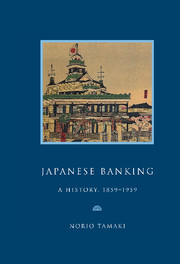Book contents
- Frontmatter
- Contents
- Preface
- Genealogy of leading Japanese banks, 1859–1959
- List of abbreviations
- Map
- Part I A bankrupt Shogunate, 1859–1868
- Part II The Meiji Restoration: monetary confusion and banking experiments, 1868–1881
- Part III Matsukata, the wizard of Japanese banking, 1881–1897; the Yokohama Specie Bank (1880) and the Bank of Japan (1882)
- Part IV The Japanese on the London money market, 1897–1911
- Part V War, the Japanese boom years, 1911–1919
- Historical background
- 17 Bank of Japan money supply, 1911–1919
- 18 The expansion of special banking, 1911–1919
- 19 Ordinary and savings banks, the search for strength, 1911–1919
- 20 Other financial sectors in the boom years, 1911–1919
- Part VI Crisis and the road to war, 1919–1937
- Part VII Complete commitment, struggle and defeat, 1937–1945
- Part VIII American ‘democratisation’ and the search for growth, 1945–1959
- An extraordinary century, 1859–1959
- Appendices
- Notes
- Bibliography
- Index
Historical background
Published online by Cambridge University Press: 03 February 2010
- Frontmatter
- Contents
- Preface
- Genealogy of leading Japanese banks, 1859–1959
- List of abbreviations
- Map
- Part I A bankrupt Shogunate, 1859–1868
- Part II The Meiji Restoration: monetary confusion and banking experiments, 1868–1881
- Part III Matsukata, the wizard of Japanese banking, 1881–1897; the Yokohama Specie Bank (1880) and the Bank of Japan (1882)
- Part IV The Japanese on the London money market, 1897–1911
- Part V War, the Japanese boom years, 1911–1919
- Historical background
- 17 Bank of Japan money supply, 1911–1919
- 18 The expansion of special banking, 1911–1919
- 19 Ordinary and savings banks, the search for strength, 1911–1919
- 20 Other financial sectors in the boom years, 1911–1919
- Part VI Crisis and the road to war, 1919–1937
- Part VII Complete commitment, struggle and defeat, 1937–1945
- Part VIII American ‘democratisation’ and the search for growth, 1945–1959
- An extraordinary century, 1859–1959
- Appendices
- Notes
- Bibliography
- Index
Summary
On 30 July 1912 the Meiji Emperor died and on that day the Taisho era commenced. Emperor Taisho, of weak mental and physical health, had none of the charisma of his father. This marked the end of an era, during which Japan had exerted herself to the utmost of her strength in order to catch up with the western powers. In February 1913, the military-clique-led cabinet was forced to resign, for the first time in Japan's modern history, by popular protest from both inside and outside the Diet. This led to the emergence of a male suffrage movement and the vague term ‘Taisho democracy’, and eventually to the formation of a party-led cabinet with the first common people premiership, Kei Hara. Indeed, because of rising prices, there were serious rice riots in 1918. In international relationships, Japan, with the Anglo- Japanese Alliance still in place, played a modest part on the Allied side in the First World War. The Japanese military, backed by strong anti-western right-wing activists, increasingly showed aggression by taking the opportunity of fishing in troubled waters in China and elsewhere. Shortly after the declaration of war against Germany in August 1914, the Japanese military took over the German territories on the Chinese mainland and presented to the Chinese the notorious Twenty-One Demands. The Russian Revolution of 1917 induced Japan, in co-operation with the western powers, to intervene in Siberia, which extended until 1925. The Taisho era, of less than fourteen years, was a period of tension, but at the same time there was an astonishingly rapid growth of the economy which produced a prosperous banking sector.
- Type
- Chapter
- Information
- Japanese BankingA History, 1859–1959, pp. 113Publisher: Cambridge University PressPrint publication year: 1995



